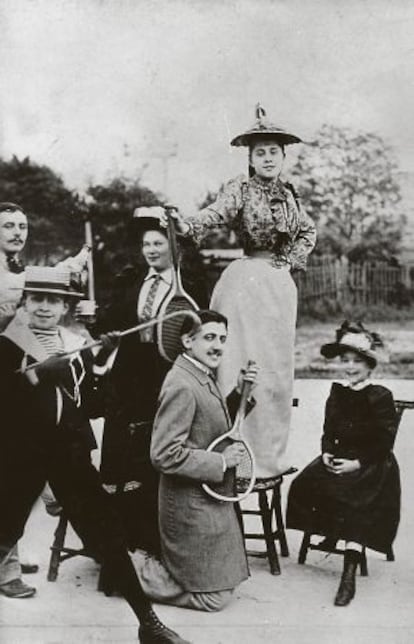A tribute to a world literature classic
France is commemorating the 100th anniversary of the first volume of Proust’s ‘In Search of Lost Time’ with new editions of the work and unseen letters

Nearly everything there is to write about Proust has been written already, but not so about In Search of Lost Time proper, because it is a classic. And the thing about classics is that they have a mysterious ability to take on new meaning with each successive generation. What this work means today is not the same as what it meant back in 1913, when volume one, Swann's Way, was first published.
The immense universe of In Search of Lost Time was put to readers' judgment just ahead of World War I through an initial fragment that made it impossible to guess the scope of the whole. The sheer scale of it was going to be massive, more than 3,000 pages, and it would have been fanciful to predict that those inaugural tiles would later become part of a giant mosaic where they would play an essential, if unpredictable, role. This is the only justification for the tremendous mistake made by Gide when he rejected the manuscript for Gallimard.
Following that first publication came one of the bloodiest conflicts ever to hit the very bloodthirsty Europe. The "Guerre de 14-18," as the French call it, strongly influenced Proust's project, and there is nothing quite as chilling as the last volume in the series, Time Regained, which takes the shape of a masked ball that brings together the characters after the war and ends a life that began with the Gothic brightness of the Duchess of Guermantes. After the war there are no more heroes: all the dashing military men, the beautiful ladies, the subtle aristocrats, the seductive teenagers of the fureur de vivre are now but macabre remains of a defunct society. The cycle of life and death is completed in that final, somber scene.
His own work was done, and although Proust did not live long enough to make corrections to the entirety, contemporary readers can read around the unpolished blocks of marble that are The Captive and The Fugitive. This does not mean that these volumes should be avoided altogether — on the contrary, they are required reading — but it is possible to analyze them less attentively than the rest of the material.
Proust's work is a lesson on how to reflect on our own vices and virtue
The fact that In Search of Lost Time never feels outdated is partly due to its not being exactly a novel, even though it is one of the greatest ever written. But it is also a lot more than that. Its hundreds of characters possess the verisimilitude of the best realistic portraits, yet they embody iconic states of mind with the same intensity as Odysseus or Don Quixote; that is to say, they are myths representing a precise and chilling review of contemporary human lifestyles and their various fates. To read In Search of Lost Time does not just entail jumping into an extremely intelligent world of fiction — it is also a lesson on how to reflect on our own vices and virtues, our ways of expressing love, our false beliefs, the things we are enslaved to, and our hypocritical truths. It is a veritable encyclopedia of modern humanity, in all its glory and stupidity.
Víctor Gómez Pin, who has written two truly philosophical books about Proust, says that the only real character in In Search of Lost Time is language itself, and that for this reason it goes far beyond the adventures of Paris's haute bourgeoisie in the 1800s. Language as our essence, the thing that makes us human, is universally morphing into nothing more than a practical tool. And as language becomes a tool, so we become tools ourselves. And yet the language of In Search of Lost Time is perfectly alien to all attempts at instrumentalization, even when the novelist is forced to respect action and suspense; thus the tenaciously long sentences and the difficulty that unnerves readers in a rush to get through the novel. We might say that Proust's language is strictly poetic in the most rigorous sense of the word, and that is why it requires a collaborative effort from us.
When one seeks, as Proust does, the poetic aspect of language, then people's everyday talk is transformed into a magic spell that lets readers penetrate into the speaker's innermost being. The manner in which one speaks is a faithful representation of the soul, and In Search of Lost Time is above all a repertory of different ways of talking. Each way of talking is a possibility for living.
In a useful collection of Proustian thoughts gathered by Jaime Fernández in El almuerzo en la hierba (or, The Luncheon on the Grass), there is the following quote: "Words did not inform me other than to interpret them as one interprets a rush of blood to the face of a blushing person, or a sudden silence."
For Proust, everyday words take on a magical ability to provoke involuntary bodily reactions. This enigmatic ability of language is what makes In Search of Lost Time a work that transforms the reader, not just emotionally but often also physically. A serious reading is not so much a reading as a language transfusion, comparable to the blood transfusions that revive a dying man. Quite possibly, this is the best way to prepare our bodies for mortality.
A century on Swann’s Way
After being summarily rejected in 1912 by Jean Schlumberger and André Gide, editors of the Nouvelle Revue Française (NRF), the manuscript of Swann's Way was published by Grasset in November 1913 after its author, Marcel Proust, covered the printing costs. Gide would soon come to realize that their decision was "the single worst mistake ever made by the NRF." Proust never forgave Gide the affront, but nevertheless allowed the magazine to publish a few fragments of The Guermantes Way, volume three of In Search of Lost Time, before allowing the first two volumes to be published by Gallimard-NRF in 1919.
A symbol of modern classicism and analytical narrative, Marcel Proust's seven-volume novel is considered a pinnacle of world narrative and remains as wonderfully suggestive today as it was 100 years ago. Meanwhile, the legendary French publishing house can still boast Proust — whose rights are in the public domain — as one of its most prominent authors.
Gallimard's own Proust specialist, Jean-Yves Tadié, author of essays on the writer's universe (such as "Proust and the novel" or "Proust and Freud") explains that translations of Du côté de chez Swann into English, Chinese and Japanese are already into their third edition, and that the French version continues to sell several hundred copies each week.
Gallimard, one of France's most prestigious cultural icons, is celebrating the centennial of volume one of In Search of Lost Time with several new publications. The first of these is a facsimile of the manuscript for Combray, part one of Swann's Way, with marginal notes and comments by Proust himself; 1,200 copies are being printed in partnership with the Martin Bodmer Foundation in Geneva. Besides that, Gallimard is also publishing previously unseen letters written by Proust to Sévérine, his neighbor on Boulevard Haussmann. According to Tadié these letters are "entertaining, funny and moving," and were preserved by Sévérine's grandson. Lastly, the publishing house will sell a luxury case containing illustrations of the character of Odette the courtesan and her noble friend.
Tadié says that the story of the rejected manuscript and the NRF editors' subsequent attempts to curry favor with the author was "an example of Proust's extreme sensitivity, and also of the extreme patience and exquisite attention lavished on him by Gaston Gallimard and Jacques Rivière, who finally convinced him to leave Grasset in the spring of 1916."
A year later, Gallimard published the original edition of Swann's Way and Proust completed volume two, Within a Budding Grove, after which he insisted on publishing the entire series as a single volume, rather than in chunks as his editors wanted.
His titanic task, which was performed against the backdrop of World War I, would be satisfactory for both parties: volume two earned the Goncourt Prize. But above all it was a triumph for readers, who, one century later, continue to be fascinated by this wonderful human and literary adventure.
Tu suscripción se está usando en otro dispositivo
¿Quieres añadir otro usuario a tu suscripción?
Si continúas leyendo en este dispositivo, no se podrá leer en el otro.
FlechaTu suscripción se está usando en otro dispositivo y solo puedes acceder a EL PAÍS desde un dispositivo a la vez.
Si quieres compartir tu cuenta, cambia tu suscripción a la modalidad Premium, así podrás añadir otro usuario. Cada uno accederá con su propia cuenta de email, lo que os permitirá personalizar vuestra experiencia en EL PAÍS.
¿Tienes una suscripción de empresa? Accede aquí para contratar más cuentas.
En el caso de no saber quién está usando tu cuenta, te recomendamos cambiar tu contraseña aquí.
Si decides continuar compartiendo tu cuenta, este mensaje se mostrará en tu dispositivo y en el de la otra persona que está usando tu cuenta de forma indefinida, afectando a tu experiencia de lectura. Puedes consultar aquí los términos y condiciones de la suscripción digital.
More information
Últimas noticias
Maduro pleads not guilty before the federal court in New York: ‘I am still the president of Venezuela’
A new test can detect Alzheimer’s from a finger prick
UN team enters Sudanese city of El Fasher after paramilitary massacre: ‘It’s like a ghost town’
A recipe for resistance: Indigenous peoples politicize their struggles from the kitchen
Most viewed
- Gilles Lipovetsky: ‘If you want to live better and fall in love, take Prozac, don’t look to philosophy’
- Alain Aspect, Nobel laureate in physics: ‘Einstein was so smart that he would have had to recognize quantum entanglement’
- Alvin Hellerstein, a 92-year-old judge appointed by Bill Clinton, to preside over Maduro’s trial in New York
- Why oil has been at the center of Venezuela-US conflicts for decades
- Cuba confirms death of 32 of its citizens in the US attack against Venezuela










































